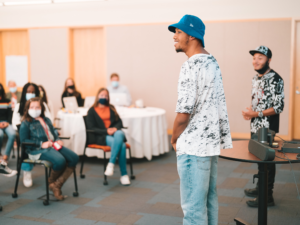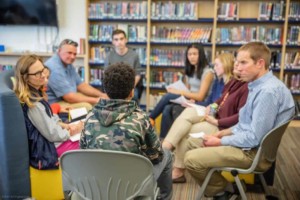Promoting Psychological Safety in Classrooms for Student Success

Getting It Right
In grammar school I stuttered,
felt the hot panic on my face
When my turn to read crept up the row.
Even when I counted the paragraphs
And memorized the passage,
I’d trip on the first or second word,
and then it would be over,
the awful hesitation, the word
clinging to the lining of my throat
rising only too late to avoid
The laughter around me. I was never
the smartest kid in the room
but I had answers I knew were right
yet was afraid to say them.
Years later it all came out, flowing
sentences I practiced over and over,
Shakespeare or Frost, my own tall tales
In low-lit barrooms, scribbled
in black-bound journals, rehearsing,
anticipating my turn, my time,
a way of finally getting it right.
-Kevin Carey
Performance terror. We’ve all known a classroom, meeting room or stage where we didn’t feel safe doing something we were quite capable of doing.
Garrison Keillor read Kevin Carey’s poem on Writer’s Almanac on Wednesday. Carey’s day job is teaching at Salem State University. “As a college professor I encourage students to read their work aloud, but I never insist on it,” said Carey. “Sometimes those who are uncomfortable doing it will volunteer on their own because it’s their decision rather than mine.”
The same day, Dena Simmons’ TED talk discussing psychological safety in classrooms was featured on the TED homepage and podcast.

Simmons grew up in a tough part of the Bronx. When her mom got her into a prestigious school in Connecticut, she felt like an imposter. But she persevered, became a teacher, and returned to the Bronx, where she created a classroom that made all students feel proud of who they are.
“I centered my instruction on the lives, histories and identities of my students. And I did all of this because I wanted my students to know that everyone around them was supporting them to be their best self,” said Simmons.
“So while I could not control the instability of their homes, the uncertainty of their next meal, or the loud neighbors that kept them from sleep, I provided them with a loving classroom that made them feel proud of who they are, that made them know that they mattered,” added Simmons.
“There is a better way, one that doesn’t force kids of color into a double bind; a way for them to preserve their ties to their families, homes and communities; a way that teaches them to trust their instincts and to have faith in their own creative genius,” said Simmons.
Safety: Key to Effectiveness
It’s never been more important to help young people develop the skills and confidence to become self-directed learners, makers, creators, problem-solvers and project managers, and it all starts with a safe place to learn.
In a study of effective teams at Google, the most important factor was creating “psychologically safe environments.” Teams that encourage safe discussions and different viewpoints succeed more.
On the good teams, members spoke in roughly the same proportion–what researchers referred to as ”equality in distribution of conversational turn-taking.” On some teams, everyone spoke during each task; on others, leadership shifted among teammates from assignment to assignment. The good teams had high social sensitivity, they had team members that could sense how others felt based on their tone of voice, their expressions and other nonverbal cues.
Culture: Key to Safety
A supportive and inclusive culture is key to psychological safety. When employees feel safe, it leads to better learning and performance outcomes, according to research by Harvard’s Amy Edmondson.
A culture of safety starts with leaders that are inclusive and humble, and that encourage their staff to speak up or ask for help, according to Edmondson. Rather than creating a culture of fear of negative consequences, feeling safe in the workplace helps encourage the spirit of experimentation so critical for innovation.
“To achieve [an emotionally safe environment], you have to find the right balance of being emotionally open and authentic without sacrificing the boundaries and hierarchy that keep you and your students secure,” suggests teacher Mark Phillips.
Schools like Deer Park Community City Schools (recently featured in this EdWeek article) are taking an innovative and blended approach to improving school culture by focusing on strengths. Thanks to a partnership between Mayerson Academy, VIA Institute on Character and Happify (an online gaming platform that supports social-emotional learning concepts), students and staff are identifying and developing character strengths and building a safe learning environment.
A study of new schools found that getting the culture was the most important factor. “Pay attention to culture,” says Pat DeKlotz, Kettle Moraine School District. “Listen to students and take the time to nurture the human element.
Advisory: Making Safety Personal
The transition to secondary schools with six to eight classes taught by different teachers can be unsettling for even the most confident students. Frequent passing periods can be a crowded maze that feel like running the gauntlet. To set the cultural tone, reinforce shared values, and connect with every student personally on a frequent (at least 3-5 times weekly) basis. Most high performing schools use an advisory system.
The goal of an advisory system is to help students figure out who they are, where they’re headed, and how they’re going to get there. Through an advisory, each student has an adult who knows them and helps them navigate high school so that they leave with a meaningful, personalized plan and are prepared for postsecondary options. In addition to guidance, an advisory structure ensures that there is a daily personal check-in with every student. Sustained adult relationships can help students navigate the complex secondary experience and spot and fix problems quickly.
Not only does advisory promote a safe environment, but, in the case of the College Spark Washington funded College Readiness Initiative, such structures have helped to boost graduation rates by providing a personalized approach to guidance.
Safety on Projects
Buck Institute for Education (BIE) editorJohn Larmer said, “It’s important to build student independence; you can’t just turn them loose and expect them to be able to effectively function autonomously. Scaffolding includes co-crafted norms, practices and routines.”
Here are eight tips from Larmer for safe spaces on project teams:
- Discuss teamwork with students, drawing from their past experience, noting what it looks like when it goes well and what can go wrong.
- Develop clear criteria for teamwork; create a collaboration rubricor another list of expectations/norms. Post guidelines on the classroom wall.
- Form teams by carefully considering who would work well together. If a particular student needs extra support or understanding (or, shall we say, special handling), put him or her with the right teammates.
- Have each team write (or give them a template) and sign a contract that spells out their agreements about working together, and the steps to be taken when they don’t (do NOT let the first step be “get the teacher!”).
- Practice collaboration skills before and during a project (e.g., use role-plays, team-building activities, fishbowl modeling, or have them practice on short, fun, low-stakes tasks).
- Teach students how to run meetings, play various roles, use conflict resolution skills and use decision-making strategies; and have students self-assess and reflect on collaboration skills at checkpoints.
- Monitor teams closely, sit in during team meetings and hold meetings with teams or team representatives to check in on progress and teamwork.
- Remember one of the benefits of PBL: chronically disengaged or absent students may be more motivated to participate if the project is engaging and/or if they have a sense of obligation to their team. Or, at the very least, they are more likely to go along with peer pressure.
A supportive culture, sustained advisory relationships, and teaching strategies that create positive learning all promote psychological safety.
“Every child deserves an education that guarantees the safety to learn in the comfort of one’s own skin,” said Simmons.
For more, see:
- There Are No Silver Bullets: 3 Levers for SEL Success
- Modeling Mistakes and Creating Trust in the Classroom
- Building Cultures of Innovation in Schools
Stay in-the-know with all things EdTech and innovations in learning by signing up to receive the weekly Smart Update. This post includes mentions of a Getting Smart partner. For a full list of partners, affiliate organizations and all other disclosures, please see our Partner page.






0 Comments
Leave a Comment
Your email address will not be published. All fields are required.